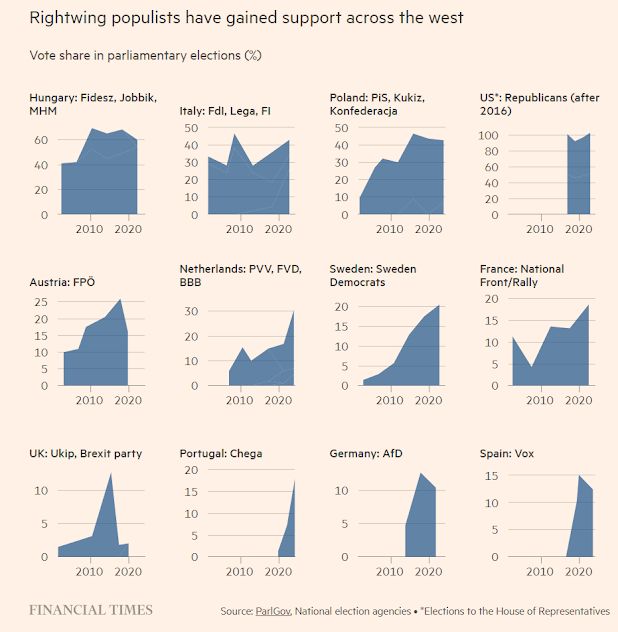Fascism has changed, but it is not dead
The 1920s and 1930s were different times but a core of traditional attitudes persists
Martin Wolf
© Efi ChalikopoulouAre we witnessing the return of fascism?
Is Donald Trump, to take the most important contemporary example, a fascist?
Is France’s Marine Le Pen?
Or Hungary’s Viktor Orbán?
The answer depends on what one means by “fascism”.
But what we are now seeing is not just authoritarianism.
It is authoritarianism with fascistic characteristics.
We must start with two distinctions.
The first is between Nazism and fascism.
As the late Umberto Eco, humanist and author of The Name of the Rose, noted in an essay on “Ur-Fascism” published in the New York Review of Books in 1995, “Hitler’s Mein Kampf is a manifesto of a complete political programme”.
In power, Nazism was, like Stalinism, “totalitarian”: it controlled everything.
Mussolini’s fascism was different.
In Eco’s words, “Mussolini did not have any philosophy: he had only rhetoric . . .
Fascism was a fuzzy totalitarianism, a collage of different philosophical and political ideas, a beehive of contradictions.”
Trump is similarly “fuzzy”.
The second distinction is between then and now.
The fascisms of the 1920s and 1930s emerged from the first world war.
They were naturally militaristic in both means and aims.
Moreover, in that age, centralised organisation was necessary if orders were to be spread.
Nowadays, social media will do much of this work.
So, today’s fascism is different from that of the past.
But this does not mean the notion is meaningless.
In his essay, Eco describes a number of characteristics of “Ur-Fascism — or Eternal Fascism”.
One feature is the cult of tradition.
Fascists worship the past.
The corollary is that they reject the modern.
“The Enlightenment, the Age of Reason,” Eco writes, “is seen as the beginning of modern depravity.
In this sense Ur-Fascism can be defined as irrationalism.”
Another feature is the cult of action for action’s sake, from which flows a further one: hostility to analytical criticism.
And it follows from this that “Ur-Fascism . . . seeks for consensus by exploiting and exacerbating the natural fear of difference . . . Thus Ur-Fascism is racist by definition.”
Another aspect is that “Ur-Fascism derives from individual or social frustration.
That is why one of the most typical features of the historical fascism was the appeal to a frustrated middle class”.
Ur-Fascism binds the supporters it recruits from the ranks of the disaffected middle class through nationalism.
Those followers, Eco adds, “must feel humiliated by the ostentatious wealth and force of their enemies”.
For Ur-Fascism, moreover, “there is no struggle for life but, rather, life is lived for struggle”.
Next, for Eco, is the fact that Ur-Fascism advocates a popular elitism.
In Ur-Fascism, he writes, “Every citizen belongs to the best people of the world.”
Moreover, “everybody is educated to become a hero.”
For Ur-Fascism, Eco adds, “the People is conceived as a . . . monolithic entity expressing the Common Will.
Since no large quantity of human beings can have a common will, the Leader pretends to be their interpreter.”
The origin of Ur-Fascism’s distinctive machismo is that “the Ur-Fascist transfers his will to power to sexual matters”.
Implied here is both disdain for women and intolerance and condemnation of non-standard sexual habits.
Finally, “Ur-Fascism speaks Newspeak” — it lies systematically.
As Hannah Arendt noted in an interview in the New York Review of Books in 1978, “If everybody always lies to you, the consequence is not that you believe the lies, but rather that nobody believes anything any longer.”
The followers believe the leader, simply because he wears the sacred mantle of leadership.
This is a fascinating list.
If one looks at today’s rightwing populism, one notices precisely the cults of the past and of tradition, hostility to any form of criticism, fear of differences and racism, the origins in social frustration, nationalism and fervent belief in plots, the view that the “people” are an elite, the role of the leader in telling his followers what is true, the will to power and the machismo.
Just this month, Trump described immigrants as “animals”, threatened a “bloodbath” if he did not win next November and lauded the insurrectionists of January 6 2021 as “unbelievable patriots”.
We know that he and his supporters intend to stuff the bureaucracy and judiciary with people personally loyal to him and criticise the legal system for holding him to account: he, after all, is above the law.
Not least, he has turned the Republican party into his own.
Yes, the movements of today are also different from those of the 1920s and 1930s.
Trump is not glorifying war, other than economic and trade wars.
But he does glorify Putin, whom he called a “genius” for his war on Ukraine.
The European politicians with roots in the fascist past are also varied.
Yet they, too, share many characteristics of Ur-Fascism, notably traditionalism, nationalism and racism, but are without some others, notably glorification of violence.
The fascism of Germany or Italy of the 1920s and 1930s does not now exist, except perhaps in Russia. But the same could be said of other traditions.
Conservatism is not what it was a century ago, as is true of liberalism and socialism.
The ideas and concrete proposals of political traditions alter with society, the economy and technology.
That is no surprise. But these traditions still have a common core of attitudes to history, politics and society.
This is also true of fascism.
History does not repeat itself.
But it rhymes.
It is rhyming now.
Do not be complacent.
It is dangerous to take a ride on fascism.


0 comments:
Publicar un comentario